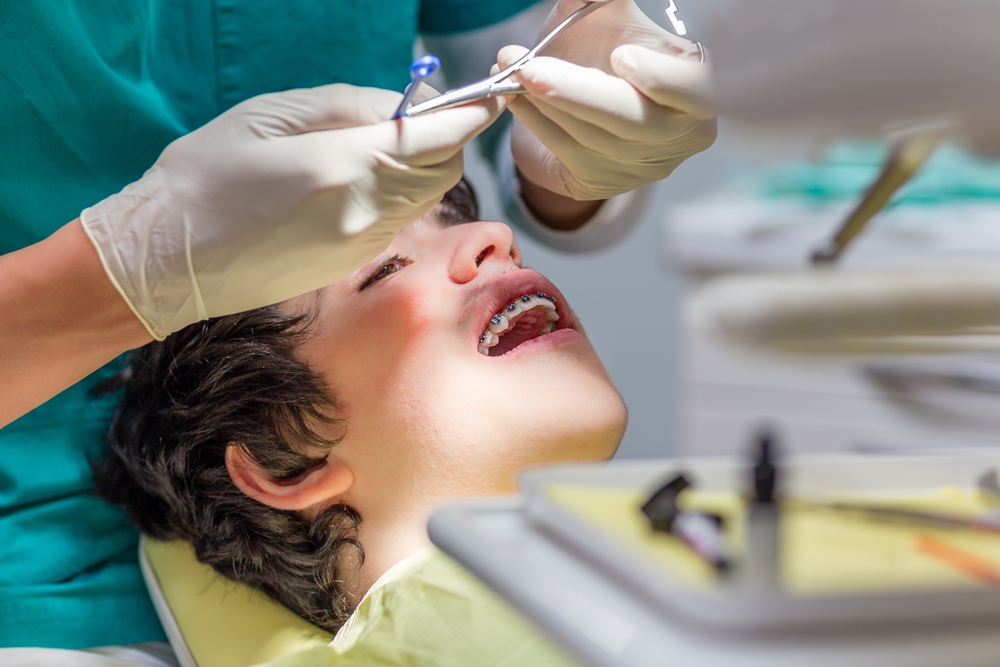
It’s back-to-school season and many of our Surrey, Abbotsford and Langley braces and Invisalign® patients are hard at work in the classroom again. In honor of the occasion, we thought we’d put together a back-to-school history lesson. We know your teachers have national and world history covered, so we’re going to be talking about the history of orthodontics. Since the field evolves so fast and there are a lot of exciting advances on the horizon, we’re also going to dive into some of the current trends in orthodontics and look ahead to the future too. Let’s discover how orthodontics got started and what it’s shaping up to look like in the coming years.
The History of Orthodontics
People have placed importance on having straight teeth for thousands and thousands of years and a desire for the perfect smile is nothing new. In fact, the ancient Egyptians used metal bands and catgut to fix crooked teeth. Then, written evidence of early orthodontics started cropping up, first with Hippocrates describing tooth irregularities around 400 BC and then Celsus, a Roman writer, discussing pushing teeth into place with a finger between 25 BC and AD 50. Pliny the Elder chimed in a few decades after Celsus suggesting aligning teeth by filing down elongated ones.
Orthodontics in the 18th Century
Advances in orthodontics were few and far between until French physician Pierre Fauchard burst onto the scene in the 18th century. He’s been called the “Father of Modern Dentistry” and the “Father of Orthodontia.” In 1728, he published the first detailed work on contemporary dentistry called Le Chirurgien Dentiste, or The Surgeon Dentist. In it, he described using a bandeau, which was a piece of metal in the shape of a horseshoe that attached to the teeth, sort of like a retainer, to shift them into place. He also used a type of forceps, he called the “pelican,” to reposition teeth. Ouch. Not surprisingly, the idea didn’t catch on or spill over to the masses for quite some time.
Orthodontics in the 19th Century
The 1800s saw rapid growth in the field of dentistry with Joseph Fox classifying malocclusion in 1803 and using appliances to align the bite. Joachim Lefoulon even coined the term “orthodontosie,” which translates loosely to “orthodontia,” in 1841. However, the big advancement was Christophe-Francois Delabarre introducing the wire crib in 1815, which was the earliest model of modern braces and a step forward in the history of orthodontics. Other dentists, including Dr. Edward Maynard and E.G. Tucker (he used rubber bands in 1846 as part of his teeth-straightening efforts), contributed and took the wire crib to the next level. In 1893, Henry A. Baker started combining the various techniques and tools and invented the “Baker Anchorage,” a method of using metal and elastics to perfect smiles without having to extract misaligned teeth.
Orthodontics in the 20th Century
The history of orthodontics took a turn for the better when Edward Angle, the “Father of Modern Orthodontics,” separated orthodontics from other types of dentistry and made it its own specialty. In the early 1900s, he started the first independent schools just for aspiring orthodontists. These professionals began focusing solely on preventing, diagnosing and treating malocclusion (an improper bite), a term he created. Teeth were no longer being pulled willy nilly. He also brought the idea of aesthetics into the forefront and promoted balancing function and form. He invented several appliances, including the edgewise appliance, which consisted of brackets and archwires – sound familiar?
During Angle’s time, Dr. Calvin Case was another prominent orthodontist and the pair debated endlessly over the use of extractions in orthodontic treatment. While they may not have agreed on pulling teeth, Case is credited with recommending the use of retainers to maintain a patient’s results.
During all of the excitement in orthodontics in the early 20th century, braces were still extremely expensive and were often made with gold or silver. Brackets were also held in place by wrapping wires around each tooth. Thankfully, in the 1970s, dental adhesives debuted and by this point, stainless steel had replaced precious metals. This reduced the cost of braces significantly and the average person was now seeking out orthodontic treatment. Lingual braces (invented by a Canadian-born orthodontist) and the first active self-ligating brackets also came into existence around this time.
In the later years of the 20th century, NASA developed a heat-activated, nickel-titanium alloy material that’s now used for many braces wires. The wires are much more flexible and when they become activated by body heat, they can deliver gentler forces more comfortably over a longer period of time and they require fewer adjustments. A company associated with NASA also created the first ceramic braces, often referred to as clear braces or invisible braces, in 1987. Who knew space-age technology was so prevalent in orthodontics?
In one final 20th century breakthrough, Zia Chishti founded Align Technology in 1997 after having adult orthodontic treatment himself. He created the basic design for Invisalign and in 1999, sales of the treatment began in North America.
Current Trends in Orthodontics
The two current trends in orthodontics that will continue to inform the future of the field are a focus on speed and a focus on comfort. At Aura Orthodontics, we offer metal and clear braces, as well as Invisalign, Invisalign Teen and dentofacial orthopedics, which involves using a variety of appliances to guide facial and jaw growth. By incorporating the newest materials, technology and techniques into these treatment options, we’ve been able to reduce treatment time and discomfort.
High-Tech Braces
Braces bracket design has improved by leaps and bounds and the brackets we use for both clear and metal braces are smaller, more streamlined and cause less irritation. Clear braces are more durable and resist staining unlike the early versions where breakage and yellowing were concerns. Whichever bracket you choose, when combined with those space-age, thin, flexible wires, we have much more control over your tooth movements. Instead of a high level of force with each adjustment, small amounts of force are gradually applied to the teeth throughout treatment. This means improved comfort and the braces work faster.
The Evolution of Invisalign
As for Invisalign, when the treatment was initially introduced, it was reserved for mild cases of malocclusion and wasn’t appropriate for more severe issues. That has changed. The aligners are now crafted with SmartTrack® material that delivers gentle force and lets Dr. Sharma and Dr. Lin control the timing of the force delivery to move certain teeth at specific times. Clear aligners are more predictable, meaning your new smile will look as promised and treatment times have been significantly reduced.
SmartForce® attachments are another recent advancement in orthodontics. The tooth-colored buttons are bonded to your teeth and give something for your Invisalign aligners to push on. This enables us to facilitate complex tooth movements that wouldn’t have been possible with aligners in the past. Dr. Sharma is even one of the few orthodontists in the world who uses Invisalign in surgical orthodontics cases. By modifying techniques, he’s able to achieve amazing results with Invisalign when jaw surgery is necessary. Our ability to address complex cases with clear aligners has been so game-changing for patients and it’s one of our favorites of the newest trends in orthodontics. Now, most patients can enjoy the comfort, convenience and aesthetics of Invisalign without compromising their outcome.
Another benefit of the improved materials and features, is that Invisalign Teen and the emerging Invisalign First allow younger patients to straighten their teeth with clear aligners. The aligners have a design that accommodates erupting teeth. Invisalign Teen can be just as effective as braces in a lot of cases and metal braces aren’t always a teenager rite of passage anymore.
Computerized Treatment Planning
Using the iTero® digital scanner for a wider range of purposes is also among the latest advancements in orthodontics. Instead of goopy, messy impressions, an Aura Orthodontics team member takes a comfortable digital scan of your mouth in just a few seconds. The images are sent to our computer and a 3D model of your mouth is developed. Dr. Sharma and Dr. Lin can plan out each individual tooth movement on the computerized model for exceptional accuracy and results. We’re even able to show our Invisalign patients what their new smile will look like before they start treatment with the Invisalign Outcome Simulator. We can also use iTero to create custom retainers, appliances and aligners that fit perfectly. Digital diagnostic tools have shortened appointments and treatment overall by giving us much more detailed visual information almost instantly.
3D Printing and Robotics in Orthodontics
Robotics in orthodontics is another recent advancement that’s exciting for doctors and patients alike. Traditionally, orthodontists manually bent archwires. However, as robotics becomes more commonplace, the robotic wire-bending technology is replacing manual bending. The wires are exact and fewer adjustments are required throughout treatment.
Though 3D printing has been a part of the teeth-straightening process for a few decades now, its presence has really ramped up. Invisalign aligners are made with 3D printing and as the technology evolves, the treatment will continue to get better. On the downside, 3D printing in orthodontics has led to mail-order aligners and DIY orthodontics. By removing the doctor from the equation, these treatments can be dangerous and lead to less than stellar results. It highlights the importance of sticking with proven technology and seeking out a specialist to plan your treatment in a way that’s safe and effective.
Future Trends in Orthodontics
We see future trends in orthodontics continuing to hone in on speed of treatment and comfort. Eventually, 3D printing or robotics will be involved in most cases and tooth movements will get more and more predictable and precise, shortening treatment times even further.
Another of the orthodontic industry trends that’s already underway is completely digital offices. At Aura Orthodontics, we’ve transitioned to be an almost entirely paperless office and it has enhanced our workflow, allowing more time to focus on treatment planning and patient care. Over the next few years, there will be very few offices who still rely on paper files and plaster models.
Because of the Internet and the incredible amount of information at our fingertips, patients have a higher orthodontic IQ than ever before. They’re well informed about many aspects of the teeth-straightening process and their treatment options. This is why we foresee that future trends in orthodontics will also include a more interactive patient experience. With digital treatment plans, we’ve been able to show patients what we have in store for their smile. Plus, certain treatments like Invisalign Teen already have compliance indicators, which makes patients an active participant in their own treatment and increases accountability. We don’t think this is far off for other forms of treatment either.
Of all of the future trends in orthodontics, the one we’re most thrilled with is the idea that treatment will be more accessible to people. Technology has increased practice efficiency and enables patients to see results faster, which means fewer appointments. It has also led to custom, cutting-edge treatments being produced on a larger scale. In time, both of these benefits will lead to reduced costs for patients. It’s similar to how prior to the 1970s, the average household couldn’t afford braces but as new materials and techniques emerged, treatment became less expensive and more practical for people. The same thing will happen again as it always does when technologies advance and are more readily available.
Dr. Sharma and Dr. Lin are committed to incorporating the latest technology into Aura Orthodontics to make our patients’ treatments more aesthetic, quicker and as pain-free as possible. By understanding the history of orthodontics and keeping an eye on the future, we’re able to stay on the leading edge of our field. If you’re looking for high-tech Surrey, Abbotsford or Langley braces or Invisalign treatment, book a free consultation at Aura Orthodontics today!





